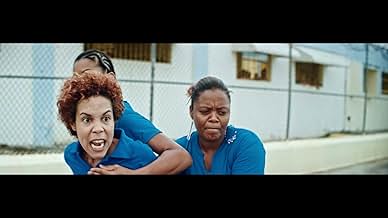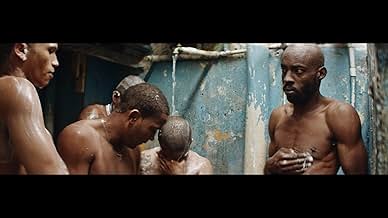Julián finds love and a reason for living in the last place imaginable: the Dominican Republic's Najayo Prison. His romance, with fellow prisoner Yanelly, must develop through sign language ... Read allJulián finds love and a reason for living in the last place imaginable: the Dominican Republic's Najayo Prison. His romance, with fellow prisoner Yanelly, must develop through sign language and without the knowledge of dozens of guards.Julián finds love and a reason for living in the last place imaginable: the Dominican Republic's Najayo Prison. His romance, with fellow prisoner Yanelly, must develop through sign language and without the knowledge of dozens of guards.
- Awards
- 14 wins & 19 nominations total
Fernando De Jesús Mejía
- Director
- (as Fernando R. de Jesús Mejía)
Ruth Matos
- Dra. Pichardo
- (as Ruth M. Matos)
Cape Ramírez
- Lissy
- (as Caperuza)
Toussaint Merionne
- Timo
- (as Toussaint)
- Director
- Writer
- All cast & crew
- Production, box office & more at IMDbPro
Storyline
Did you know
- TriviaThe film, based on real events, uses real prison locations and non professional actors throughout.
- ConnectionsFeatured in IRIS Dominicana Movie Awards (2018)
Featured review
Julián Sosa (Jean Jean) finds love and a purpose to living in the last place he imagined: Najayo prison in the Dominican Republic. Through an invented sign language from one prison to another he encounters Yanelly (Judith Rodriguez Perez), separated by 150 meters and dozens of guards; he attempts to win her love while keeping it a secret from her dangerous ex-boyfriend.
First and foremost, the film and its creators must be commended for use of the actual prison locations. The prison in the film is dirty, grimy and we see what passes for a "good meal" is not particularly appealing. The Najayo Women's Center of Correction and Rehabilitation across the way appears slightly nicer, but make no mistake that this is still a prison. In fact, some of the "actors" in the film are real-life inmates.
What makes the choice of filming even more astounding is how not that long ago it was considered one of the worst prisons in the western world. One inmate in 2009 said, "There were people sleeping on the floor all over the place, men sleeping standing up like animals. It was hell." And then you have the case of Rolando Florian Feliz.
In May 2009, Florián was killed by a prison official during an altercation in the yard. Florian, drunk and unarmed, had been shot eight times. The investigation of his death turned up evidence that Florian had been living a luxurious lifestyle granted by the prison staff. Florián lived in a set of cells that had been joined into a single apartment. He enjoyed the use of electric appliances, including air conditioning and a refrigerator. He had fully furnished rooms, including a personal collection of books, paintings, portraits, flat television screen and more. On multiple occasions, guards brought him alcohol and underage prostitutes.
Although "Woodpeckers" is fiction, some of this disparity is addressed, with some inmates clearly getting more privileges than others. Drugs flow freely if you know who to talk to, and even cell phones are smuggled in with relative ease. And then there is the gang factor. In American prisons, gangs are often divided by race; notoriously, there are more Aryan Brotherhood members in the prison system than outside of it. The divisions in the film's prison are more nuanced, with a general distrust between Haitians and Dominicans. I asked the director about this.
Jose Maria Cabral explains that unlike the United States, "I don't think it's a race or class issue; it's more a xenophobia issue. On this small island we're divided by two languages, two cultures, two sides of history and all that becomes really intense when we start sharing space with one another. On top of that the government always uses immigration issues to spread fear in the population. But, as you can see in the movie, all those obstacles are defeated by the main characters through a new language, the woodpecking, stating that not even distance, race, class or background are obstacles for love." The "woodpecking" he refers to here (and in the film's title) is based on reality, and is fascinating in itself. With the male and female prisons separated by a moderate distance, the inmates have developed an evolving sign language. Exactly how it is taught between prisons is unclear, but it is a powerful force. We see entire romantic relationships blossom among people who may never meet face to face or even hear each other's voices. This five or ten minutes a day gesturing is their entire world.
And this dichotomy that Cabral has fictionalized here is so rich with emotion that it succeeds as both a prison film and a romance. (Which is nice, since if it was just a romance it might lose some of the less sentimental viewers.) Dominican cinema is blowing up right now, growing fourfold in the last five years; Jose Maria Cabral is at the forefront of this movement. The evidence is simple: "Woodpeckers" has been selected as the Dominican entry for the Best Foreign Language Film at the 90th Academy Awards.
The film opens at better theaters on September 15, 2017.
First and foremost, the film and its creators must be commended for use of the actual prison locations. The prison in the film is dirty, grimy and we see what passes for a "good meal" is not particularly appealing. The Najayo Women's Center of Correction and Rehabilitation across the way appears slightly nicer, but make no mistake that this is still a prison. In fact, some of the "actors" in the film are real-life inmates.
What makes the choice of filming even more astounding is how not that long ago it was considered one of the worst prisons in the western world. One inmate in 2009 said, "There were people sleeping on the floor all over the place, men sleeping standing up like animals. It was hell." And then you have the case of Rolando Florian Feliz.
In May 2009, Florián was killed by a prison official during an altercation in the yard. Florian, drunk and unarmed, had been shot eight times. The investigation of his death turned up evidence that Florian had been living a luxurious lifestyle granted by the prison staff. Florián lived in a set of cells that had been joined into a single apartment. He enjoyed the use of electric appliances, including air conditioning and a refrigerator. He had fully furnished rooms, including a personal collection of books, paintings, portraits, flat television screen and more. On multiple occasions, guards brought him alcohol and underage prostitutes.
Although "Woodpeckers" is fiction, some of this disparity is addressed, with some inmates clearly getting more privileges than others. Drugs flow freely if you know who to talk to, and even cell phones are smuggled in with relative ease. And then there is the gang factor. In American prisons, gangs are often divided by race; notoriously, there are more Aryan Brotherhood members in the prison system than outside of it. The divisions in the film's prison are more nuanced, with a general distrust between Haitians and Dominicans. I asked the director about this.
Jose Maria Cabral explains that unlike the United States, "I don't think it's a race or class issue; it's more a xenophobia issue. On this small island we're divided by two languages, two cultures, two sides of history and all that becomes really intense when we start sharing space with one another. On top of that the government always uses immigration issues to spread fear in the population. But, as you can see in the movie, all those obstacles are defeated by the main characters through a new language, the woodpecking, stating that not even distance, race, class or background are obstacles for love." The "woodpecking" he refers to here (and in the film's title) is based on reality, and is fascinating in itself. With the male and female prisons separated by a moderate distance, the inmates have developed an evolving sign language. Exactly how it is taught between prisons is unclear, but it is a powerful force. We see entire romantic relationships blossom among people who may never meet face to face or even hear each other's voices. This five or ten minutes a day gesturing is their entire world.
And this dichotomy that Cabral has fictionalized here is so rich with emotion that it succeeds as both a prison film and a romance. (Which is nice, since if it was just a romance it might lose some of the less sentimental viewers.) Dominican cinema is blowing up right now, growing fourfold in the last five years; Jose Maria Cabral is at the forefront of this movement. The evidence is simple: "Woodpeckers" has been selected as the Dominican entry for the Best Foreign Language Film at the 90th Academy Awards.
The film opens at better theaters on September 15, 2017.
Details
- Runtime1 hour 46 minutes
- Color
- Aspect ratio
- 3:1
Contribute to this page
Suggest an edit or add missing content

























